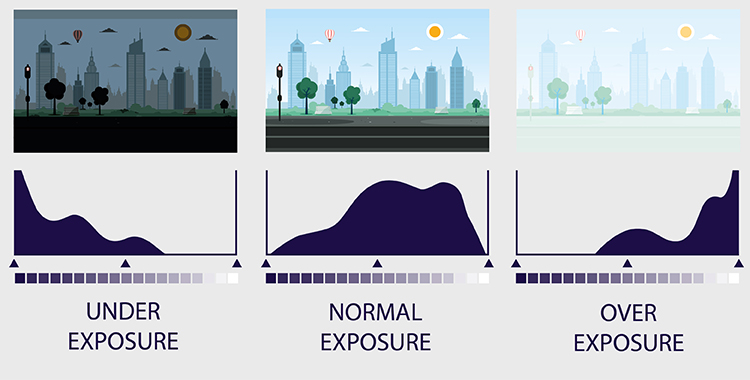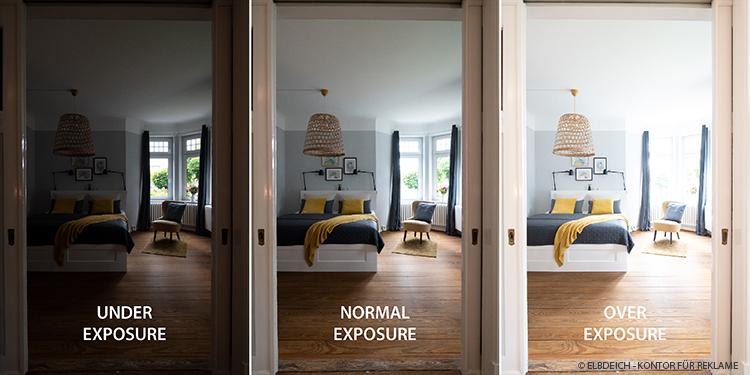HDR Bracketing: Take your photos to the next level
Even exposure. Details and structures in every image detail. For many photos this is essential, for example in real estate photography. But sometimes it is simply not possible to achieve the perfect exposure in just one shot and capture all the details in all areas. Varying lighting conditions, highlights and shadows are a challenge and often lead to overexposure and underexposure, resulting in loss of details.
The solution: HDR Bracketing!
HDR Bracketing makes it possible to capture a wide range of lighting at once. How? By merging multiple photos with different exposures into one perfect HDR photo.

Together with our customer ELBDEICH – Kontor für Reklame, specialist in professional photography for holiday properties and architecture, we explain to you what HDR Bracketing is all about.
What does HDR mean?
HDR stands for High Dynamic Range and is a technique to make it possible to increase the dynamic range, colours and contrasts, of photos. In photography, we speak of HDR images, high contrast images. A series of images with different exposures are combined into one picture. In these very high-contrast images, both light and dark areas are very clearly visible.
HDR images are particularly helpful for motifs with large differences in brightness. The human eye copes better with different brightnesses and contrasts than a photo sensor. Where our eyes still recognise structures in bright or dark areas, the details are often missing in photos. Areas that are too dark can usually be lightened up to some extent in post-processing, so that details that were previously difficult to see can be revealed. However, this is not possible the other way round. If parts of the image are too bright or even absolutely white, image information is missing and cannot be generated by editing.
HDR allows to take high-contrast, evenly exposed photos with a very high range of light and dark. Wider than with normal cameras, as if you are seeing a motif with your own eyes.
What is HDR Bracketing?
HDR Bracketing is (also) a digital image editing method. In this process, several images of a motif are first taken with different exposure times and the individual images are then manually merged into one image. The resulting HDR image does not contain any overexposed or underexposed areas and covers a larger dynamic range than the individual images. Details and contrasts are clearly visible in bright, dark and normally exposed areas. The process is also known as HDR Blending or Exposure Bracketing.

And this is how HDR Bracketing works
Individual images with different exposures
The basis is usually at least three individual images of the same motif, taken with different exposure times.
1. Underexposed shot: With a low brightness range, the image is too dark overall. Details disappear in dark areas and shadows. Bright and white areas appear greyish, but details are visible.
2. Evenly exposed shot: A normal, balanced exposure comes closest to reality. Shadows and highlights contain a relatively large amount of detail. Details are only lost in very dark or bright areas.
3. Overexposed shot: 3. The image has a high brightness range, which means it is too bright overall. The highlights, the brightest parts of the image, hardly contain any details. Dark and black areas of the image are grey but still have some details.

For example, look at this picture where bright daylight is shining through a window. The underexposed photo is oriented towards the brightest areas and shows them in the correct exposure. Other areas are underexposed, meaning too dark. The overexposed photo is based on the shadows, causing bright areas to lose detail. The evenly exposed photo shows detail in both bright and dark areas. Overall, however, the picture appears a bit low in contrast, and details are missing here and there.
Merging into an HDR image
The individual images are now combined to create an HDR image. For this purpose, the correctly exposed image parts of the individual images are used and thus details from each image are cleverly combined. The underexposed image adds details to the bright areas. From the overexposed shot, dark areas get their structures and details. This gives both highlights and shadows a balanced, optimal exposure, and any details and structures are perfectly kept and recognisable in all areas.
Fine-tuning for perfection
But the work is not over yet. For a perfect result, the merged image is further processed manually. This includes, among other things, image retouching with adjustments to brightness, contrast and tone. Colour correction for accurate colour reproduction. As well as, for example, the removal of disturbing image elements.

The result is a perfect, evenly balanced, and exposed HDR image full of brilliant detail, contrast, and colour in all areas.
When should you use HDR Bracketing?
There are many situations where HDR is beneficial. In some, HDR is the only way to bring out all the details and give your photos that extra something.

HDR Bracketing is used frequently, especially in real estate photography, for both indoor and outdoor photos. Evenly exposed photos that capture every detail are essential for real estate photos.
Landscape photos almost always benefit from HDR Bracketing. Normal shots often produce either a very bright, overexposed sky or conversely, a dark, underexposed ground. Photos taken in bright sunshine, such as portraits, get much more even lighting with HDR Bracketing and the images are more balanced overall.
Your benefits
– Professional HDR image sensors and cameras are expensive. Manual HDR Bracketing is more affordable and even more accurate.
– Through manual editing, each image area can be individually adjusted to perfection.
– You overcome difficult lighting conditions and get images with balanced highlights and shadows.
– Less loss of detail, improved textures and sharpness.
– The technique is suitable for both indoor and outdoor photos.
– The result is brilliant images with unimagined details.
We take your photos to the next level – With professional HDR Bracketing!
- 2023
- January (1)
- 2022
- December (2)
- November (1)
- October (2)
- September (2)
- August (1)
- July (1)
- June (1)
- May (1)
- April (1)
- March (1)
- February (1)
- January (3)
- 2021
- December (2)
- November (1)
- October (3)
- September (2)
- August (1)
- July (3)
- June (1)
- May (2)
- April (1)
- March (1)
- February (2)
- January (4)
- 2020
- December (2)
- November (3)
- October (4)
- September (1)
- August (2)
- July (1)
- June (2)
- May (3)
- April (3)
- March (3)
- February (4)
- January (4)
- 2019
- December (1)
- November (2)
- October (5)
- September (1)
- August (3)
- July (2)
- June (2)
- May (3)
- April (2)
- March (3)
- February (2)
- January (4)
- 2018
- December (2)
- November (2)
- October (3)
- September (3)
- August (2)
- July (2)
- June (2)
- May (1)
- April (1)
- March (2)
- February (3)
- January (2)
- 2017
- December (2)
- November (2)
- October (1)
- September (1)
- August (1)
- July (1)
- June (1)
- May (1)
- April (1)
- March (1)
- February (1)
